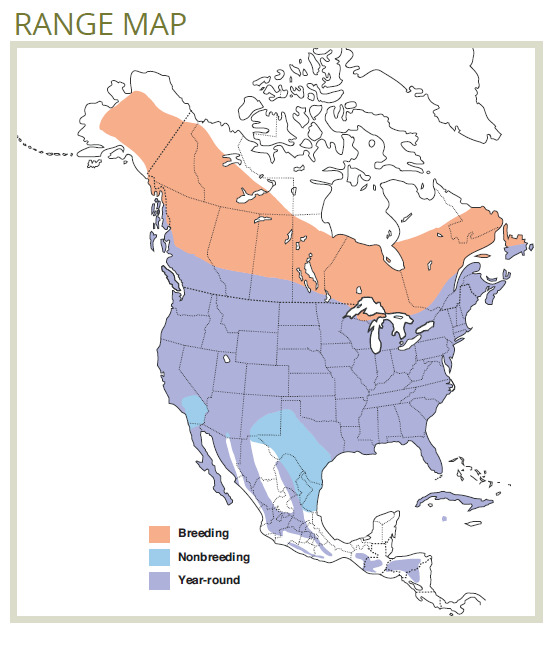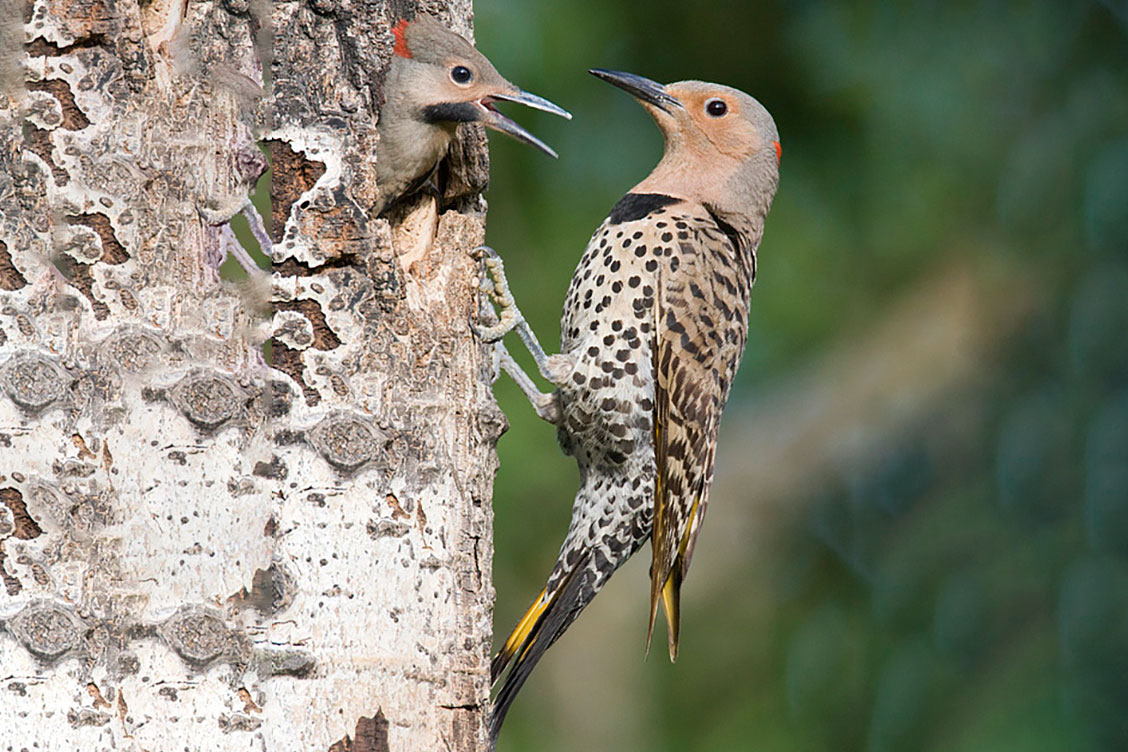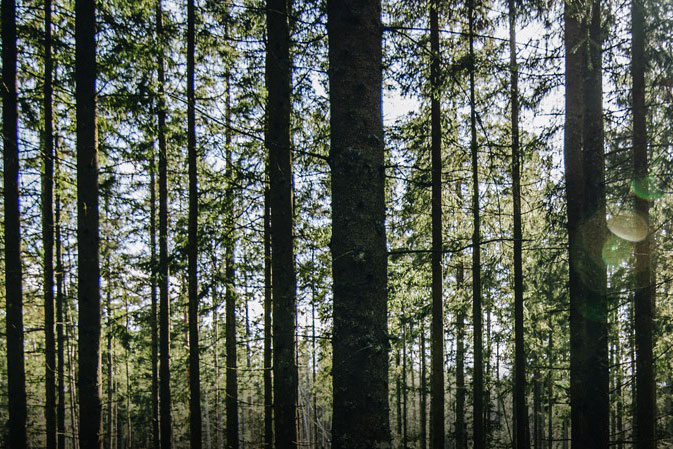This woodpecker is easily identified by the dark polka-dots on its underside, although its call sounds quite similar to that of the Pileated Woodpecker. The Northern Flicker spends a lot of time foraging for insects on the ground.
Northern Flicker
(Colaptes auratus)
Habitat Ecology
- The Northern Flicker is a ground-foraging species found in a wide range of forest habitats including deciduous-dominated and mixed-conifer stands. It is typically found along in or near forest edges and open woodlands.1
- This species is most common in <30 year-old burned forests, suggesting the high importance of burned stands.2
- Northern Flickers mainly excavate cavities in aspen >35 cm dbh, which they will preferentially select even in conifer-leading stands.3–5 They prefer recently dead trees with up to 50% of branches and bark missing4 and/or false tinder conks.6
- Northern Flickers may preferentially select nest trees where many suitable nest trees occur within a 10 m radius.6

Response to Forest Management
- Retention harvesting appears to benefit Northern Flicker habitat in deciduous or deciduous-coniferous forests. They have responded positively to patch retention and riparian buffers totalling ~20% forest cover7 and large aggregated harvests containing 29–33% merchantable retention.3
- This species was likely to be found in young regenerating clearcuts (1–11 years postharvest), possibly due to increased ground-foraging opportunities.8 Given the Northern Flicker’s large territory size, it seems likely that nearby unharvested forest was an important source of nest trees.
- However, in dry mixed-conifer forests (ponderosa pine/Douglas fir), salvage logging with 40% retention of snags >23 cm dbh caused Northern Flicker to decline relative to burned, unsalvaged forest.9,10
- Harvesting and/or fragmentation may make Northern Flicker more vulnerable to nest theft by European Starlings in dry mixedconifer forests of interior BC.11
Stand-level Recommendations
- Managers should prioritize aspen >35 cm dbh with false tinder conks and/or recently dead aspen for retention. Residual patches <0.5 ha and single trees provide short-term benefits, while larger patches may have greater longevity.3,6,12
- During salvage logging of burned stands, large-diameter snags should be prioritized for retention. In western woodlands, an average snag density of 93 snags per 100 ha is predicted to be optimal.1
Landscape-level Recommendations
- The Northern Flicker is likely to benefit from management strategies that maintain representative amounts of early- and late-seral forests, as observed in an NRV scenario. Burned forests are most important to them. Uneven-aged management (e.g., retention harvesting) will increase nesting opportunities across the harvested landscape in the short and long term.
References
- Wiebe, K. L. & Moore, W. S. 2017. Northern Flicker (Colaptes auratus), version 2.1. in The Birds of North America (Rodewald, P. G., ed.) Cornell Lab of Ornithology, Ithaca, New York, USA.
- Schieck, J. & Song, S. J. 2006. Changes in bird communities throughout succession following fire and harvest in boreal forests of western North America: literature review and meta-analyses. Canadian Journal of Forest Research 36: 1299–1318. Available online: https://doi.org/10.1139/x06-017
- Cooke, H. A. & Hannon, S. J. 2011. Do aggregated harvests with structural retention conserve the cavity web of old upland forest in the boreal plains? Forest Ecology and Management 261: 662–674. Available online: http://dx.doi.org/10.1016/j.foreco.2010.11.023
- Blanc, L. A. & Martin, K. 2012. Identifying suitable woodpecker nest trees using decay selection profiles in trembling aspen (Populus tremuloides). Forest Ecology and Management 286: 192–202.
- Drever, M. C. & Martin, K. 2010. Response of woodpeckers to changes in forest health and harvest: Implications for conservation of avian biodiversity. Forest Ecology and Management 259: 958–966.
- Cooke, H. A. & Hannon, S. J. 2012. Nest-site selection by old boreal forest cavity excavators as a basis for structural retention guidelines in spatially-aggregated harvests. Forest Ecology and Management 269: 37–51. Available online: http://dx.doi.org/10.1016/j.foreco.2011.12.042
- Lance, A. N. & Phinney, M. 2001. Bird responses to partial retention timber harvesting in central interior British Columbia. Forest Ecology and Management 142: 267–280.
- Leston, L., Bayne, E. & Schmiegelow, F. 2018. Long-term changes in boreal forest occupancy within regenerating harvest units. Forest Ecology and Management 421: 40–53. Available online: https://doi.org/10.1016/j.foreco.2018.02.029
- Saab, V. A., Russell, R. E. & Dudley, J. G. 2007. Nest densities of cavity-nesting birds in relation to postfire salvage logging and time since wildfire. The Condor 109: 97–108. Available online: http://www.bioone.org/doi/abs/10.1650/0010-5422(2007)109[97:NDOCBI]2.0.CO;2
- Saab, V. A., Russell, R. E. & Dudley, J. G. 2009. Nest-site selection by cavity-nesting birds in relation to postfire salvage logging. Forest Ecology and Management 257: 151–159.
- Walter, S. T. & Maguire, C. C. 2005. Snags, cavity-nesting birds, and silvicultural treatments in western Oregon. Journal of Wildlife Management 69: 1578–1591.
- Cooke, H. A., Hannon, S. J. & Song, S. J. 2010. Conserving Old Forest Cavity Users in Aggregated Harvests with Structural Retention. Sustainable Forest Management Network, Edmonton, AB. 36 pp. Available online: https://doi.org/10.7939/R3JQ0SW3P








